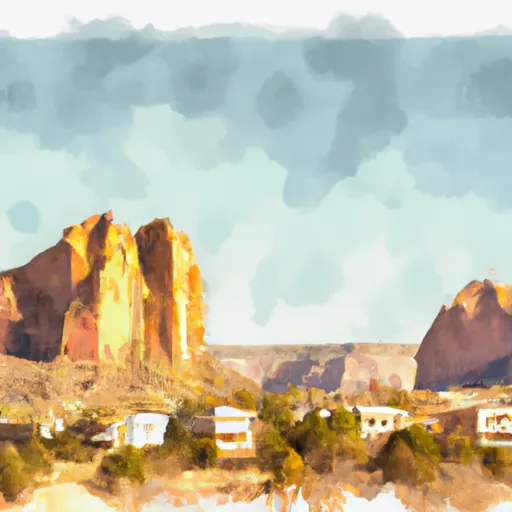-
 Snoflo Premium
Snoflo Premium
Get unlimited access to all our content
With no Ad interruptions! - Start Your Free Trial Login with existing account
Window-Rock
Eden Index
Climate
8.3
•
Recreation
•
Community
0.3
•
Safeguard
3.4/10

Window Rock is a small town located in Apache County, Arizona, with a population of approximately 3,000 people. Situated at an elevation of 6,412 feet, the town experiences a semi-arid climate characterized by hot summers and cold winters. Summers are typically dry with temperatures often exceeding 90°F, while winters are cold with occasional snowfall.
Window Rock is surrounded by stunning natural beauty, with the dominant feature being the majestic Window Rock itself. This iconic sandstone formation stands as a sacred landmark for the Navajo Nation. The town also lies near the Arizona/New Mexico border, offering easy access to the natural wonders of both states.
In terms of hydrology, Window Rock is close to the Puerco River, which flows eastward and plays a vital role in the region's ecosystem. The river supports a variety of plant and animal life, making it an excellent spot for birdwatching and wildlife observation.
Outdoor recreation opportunities abound in Window Rock, including hiking, camping, and fishing. Nearby attractions such as the Canyon de Chelly National Monument and the Chuska Mountains provide endless opportunities for outdoor enthusiasts to explore and enjoy the natural beauty of the area.
What is the Eden Index?
The Snoflo Eden Index serves as a comprehensive rating system for regions, evaluating their desirability through a holistic assessment of climate health, outdoor recreation opportunities, and natural disaster risk, acknowledging the profound impact of these factors on livability and well-being.
Climate Health Indicator (CHI): 8.3
Window-Rock receives approximately
283mm of rain per year,
with humidity levels near 69%
and air temperatures averaging around
10°C.
Window-Rock has a plant hardyness factor of
6, meaning
plants and agriculture in this region thrive during a short period during spring and early summer. Most
plants will die off during the colder winter months.
By considering the ideal temperature range, reliable water supplies, clean air, and stable seasonal rain or snowpacks, the Climate Health Indicator (CHI) underscores the significance of a healthy climate as the foundation for quality living.
A healthy climate is paramount for ensuring a high quality of life and livability in a region, fostering both physical well-being and environmental harmony. This can be characterized by ideal temperatures, reliable access to water supplies, clean air, and consistent seasonal rain or snowpacks.
Weather Forecast
Streamflow Conditions
Little Colorado
Area Rivers
Little Colorado
Snowpack Depths
Little Colorado
Reservoir Storage Capacity
Little Colorado
Groundwater Levels
Recreational Opportunity Index (ROI):
The Recreational Opportunity Index (ROI) recognizes the value of outdoor recreational options, such as parks, hiking trails, camping sites, and fishing spots, while acknowledging that climate plays a pivotal role in ensuring the comfort and consistency of these experiences.
Access to outdoor recreational opportunities, encompassing activities such as parks, hiking, camping, and fishing, is crucial for overall well-being, and the climate plays a pivotal role in enabling and enhancing these experiences, ensuring that individuals can engage in nature-based activities comfortably and consistently.
Camping Areas
| Campground | Campsites | Reservations | Toilets | Showers | Elevation |
|---|---|---|---|---|---|
| Wheatfields Lake | 25 | 7,316 ft | |||
| Camp Asaayi | None | 7,517 ft |
Catastrophe Safeguard Index (CSI):
The Catastrophe Safeguard Index (CSI) recognizes that natural disaster risk, encompassing floods, fires, hurricanes, and tornadoes, can drastically affect safety and the overall appeal of an area.
The level of natural disaster risk in a region significantly affects safety and the overall livability, with climate change amplifying these risks by potentially increasing the frequency and intensity of events like floods, fires, hurricanes, and tornadoes, thereby posing substantial challenges to community resilience and well-being.
Community Resilience Indicator (CRI): 0.3
The Community Resilience Indicator (CRI) recognizes that education, healthcare, and socioeconomics are crucial to the well-being of a region. The CRI acknowledges the profound impact of these elements on residents' overall quality of life. By evaluating educational resources, healthcare accessibility, and economic inclusivity, the index captures the essential aspects that contribute to a thriving community, fostering resident satisfaction, equity, and social cohesion.

